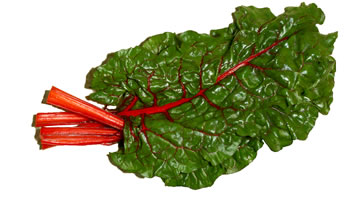Chard (Swiss Chard)

While closely related to spinach and beets, chard, commonly referred to as Swiss Chard, takes on a slightly more earthy and robust flavor. Chard packs a huge amount of Vitamins and Minerals and contains natural sodium. Like spinach this green has a mild flavor that easily goes unnoticed when consumed raw in smoothies, sauces and most dishes. An excellent choice for green smoothie beginners and veterans alike, as well as a fantastic choice in
a stir-fry.
Excellent Source of:
- Vitamin A, Vitamin C, Vitamin E, Vitamin K
- Vitamin B6, Vitamin B2
- Folate
- Thiamin
- Sodium
- Calcium
- Magnesium, Iron, Manganese, Potassium, Phosphorus, Zinc, Copper
- Protein
- Fiber
| Nutrition Facts | ||||||
| Serving Size 36g (~1 cup chopped) | ||||||
| Amount Per Serving | ||||||
| Calories 7 |
Calories from fat 1
|
|||||
|
% Daily Value*
|
||||||
| Total Fat 0g |
0%
|
|||||
| Saturated Fat 0 g |
0% |
|||||
| Cholesterol 0 mg |
0%
|
|||||
| Sodium 77 mg |
3%
|
|||||
| Total Carbohydrate 1 g |
0%
|
|||||
| Dietary Fiber 1 g |
2%
|
|||||
| Sugars 0 g | ||||||
| Protein 1g | ||||||
| Vitamin A |
44%
|
|||||
| Vitamin C |
18%
|
|||||
| Calcium |
2%
|
|||||
| Iron |
4%
|
|||||
| *Percent Daily Values are based on a 2000 calorie diet. Your Daily value may be higher or lower depending upon your calorie needs. | ||||||
Chard Green Smoothie Recipe:
- 1 banana
- 1/4 cup red grapes
- 1 Lrg Chard leaf
(~1 cup chopped) - ~ 3/4 cup water
Simple, delicious and a powerhouse of anti-oxidants and usable calcium.
Chard is commonly available in many different varieties and colors. While at its best during the summer months of June through August, Chard is available throughout the year and can be seen growing during the snowy months. As with most leafy greens, it’s best to store Chard dry, kept in a bag with a moist paper towel. While the leaves can stay fresh for several days in the refrigerator, the stalks can last longer when removed from the leaves.
* Nutrition Source: USDA National Nutrient Database for Standard Reference


